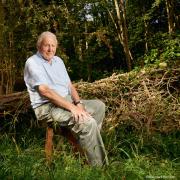Community group The Forgotten Frontline, cartoonist Dave Chisholm and historian Mark Harrison have created The Whitstable Tapestry, on display all year
A collaboration between community group The Forgotten Frontline, cartoonist Dave Chisholm and historian Mark Harrison has resulted in the creation of The Whitstable Tapestry, depicting the defence works and fortifications that were constructed along the coast during the Second World War.
Sponsors and supporters of the splendid 3.5m long cartoon gathered for the grand unveiling at The Sportsman Restaurant in Seasalter, which features in the historically and archaeologically accurate depiction of the anti-invasion defences that were built along the coast between the Michelin-starred restaurant and Whitstable Harbour.
The Sportsman’s location puts it in the thick of this ‘Coastal Crust’ which consisted of minefields, tank traps, road blocks, barbed wire entanglements, pill boxes, miles of ‘Z1’defence scaffolding and many other ingenious methods designed to thwart the expected invasion.
On 27 September 1940 soldiers of The London Irish Rifles, who were billeted at The Sportsman, exchanged fire with the crew of a Junkers 88 bomber that had been shot down and crash landed near the pub.
The Battle of Graveney Marsh was the last ground engagement involving a foreign force on the British mainland. After a German crewman was shot in the foot the Germans surrendered, and everyone retired to the pub for beers. The Junkers, fitted with innovative radar equipment, was of great use to military intelligence.
The Whitstable Tapestry depicts the battle, plus many other wartime events that took place along the five-mile stretch of coast. Removal of huge parachute mines from deep intertidal silt, developmental flame warfare technology, camouflage methods and depictions of the various defence services are all included.
The piece has been dubbed The Whitstable Tapestry after similar scenes shown on The Bayeux Tapestry, such as William Duke of Normandy ordering engineers and troops to construct defence works at Hastings.
The exact configuration of the Second World War defences has been pieced together by The Forgotten Frontline’s painstaking research into the fragments that remain, contemporary photos, written and verbal eye-witness reports, Home Guard and other maps, German and British aerial photographs and newspaper articles.
The use of demolition records is considered to be a groundbreaking research methodology that has allowed the team to produce an extremely accurate illustration. The project was funded by Kent County Council and boosted by an array of helpers and supporters.
• The Whitstable Tapestry will be on display in The Whitstable Museum and Gallery throughout 2018. Its use in school workshops and community groups will prove a fun and colourful way to broaden the appeal of The Forgotten Frontline’s incredible history.



























